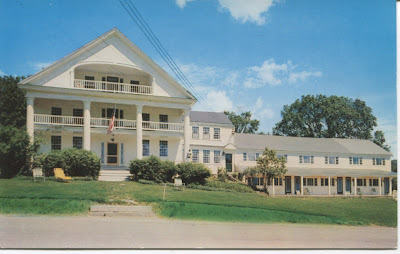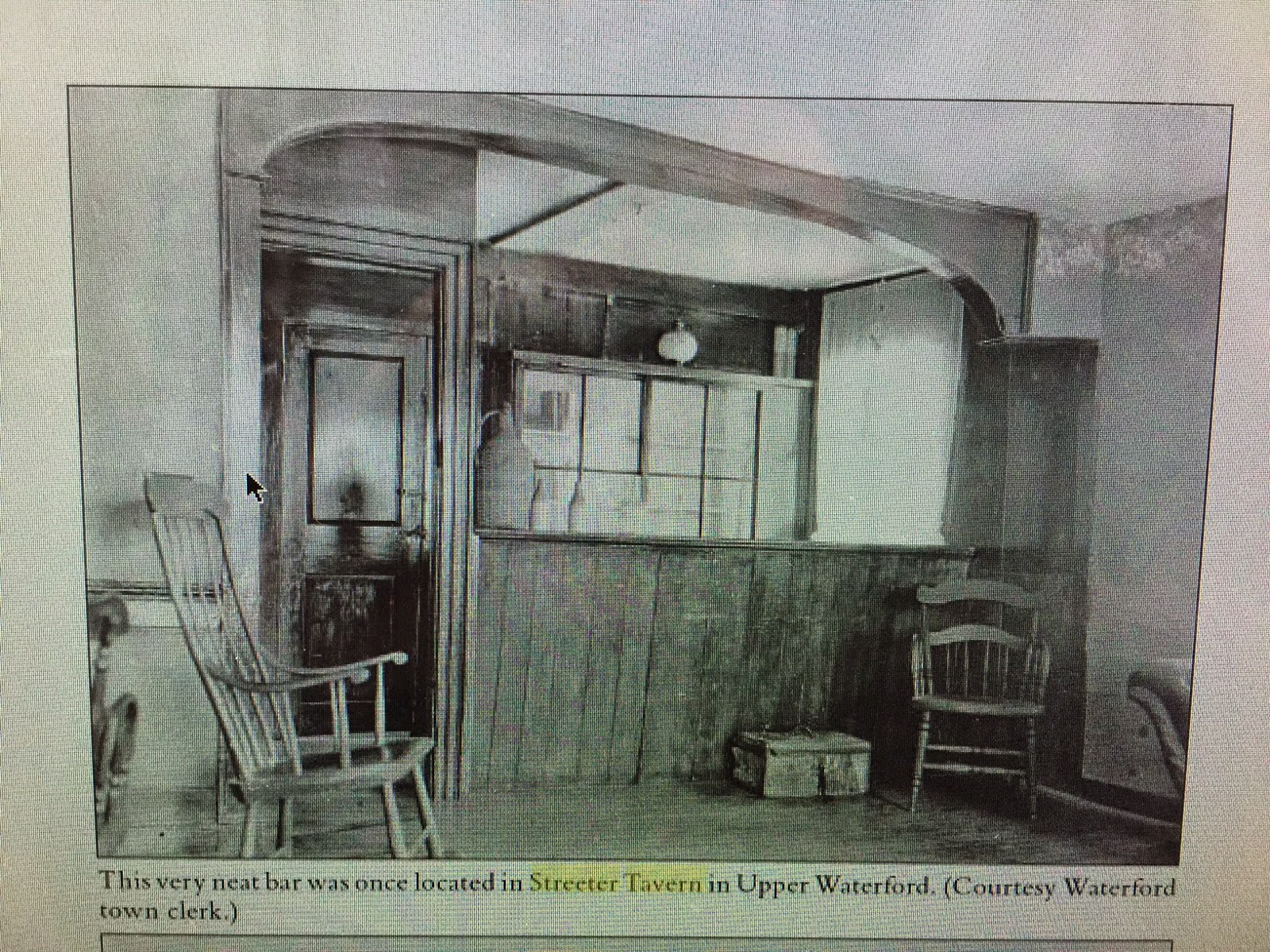Amos B. (Bugbee) Carpenter (1818-1904) was a postmaster in West Waterford; his family members included Cosbi Bowman (Parker) Carpenter (his wife) and Mabel (his daughter), who also were postmasters, so that, with brief interruptions, the Carpenters managed the West Waterford post office from its opening in 1856 to its closing in 1905. That may be one reason that letters from and to the family have come my way recently. In April 2015, I posted a letter from Amos B. to his son Amos H. (Herbert) Carpenter, who was known as Herbert. The letter was from 1889, after Herbert had gone West (born 1855 in Waterford; died 1933 in Stockton, California; buried at Mt. Pleasant Cemetery, St Johnsbury, VT).
Happily, I was able to purchase two more Carpenter-family items this fall, both addressed to Amos H. (Herbert) before he'd left the area. In fact, they turned out to include three letters from home, sent to Herbert while he was a student at Dartmouth College in Hanover, NH. Herbert graduated from Dartmouth in 1878, and all three letters were probably written in 1877. They are rich with affection, local news (gossip!), and some insight into the certification and working roles of teachers in Waterford's small schoolhouses. Here is a photo -- followed by the transcription. "May" is most likely Mabel, who later has the post office, and I think her letter (the last one here!) is a lot of fun, little sister to big brother. You'll see there's also a mystery in the letters, regarding "George" -- anyone know who he was and what happened to him? Let's keep adding to this local history.
ENVELOPE 1:
Envelope is imprinted with green three cents postage emblem
at top right; printed “If not delivered within 10 days, to be returned to” at
left but no return address; postmark WEST WATERFORD VT MAR 5 (presumed 1877);
and addressed to A Herbert Carpenter / Dart. / Hanover / N.H.”
LETTER:
Sunday eve
Dear Herbert – It is prayer meeting night and I am along in
this part of the house, nothing to disturb me but my thoughts, they wander to
you & wonder what you are doing, perhaps you are at prayer
meeting[,] perhaps reading, perhaps writing, doing nothing wrong I hope. Have
all of the students got back yet[.] poor George I always think of him[.] I
suppose you do not hear the students say anything about him, I hope they will
not hear where he is, he writes to the girls to be sure and let no one know
where he is, he inquires particularly about you – he says he is contented, but
submissive, Flora came home the next Saturday after you left, they want her
again next year, Emily came home last week, is going to Burk to work for a
minister several months, Flora is going to Mr Peabody, this spring do not know
how long she will stay, she thinks she must be earning something all the time,
Helen came home last week, is going to stay here this spring and teach the
children. Papa would like to have her stay all summer, but I suppose she cannot
afford it[,] the children are sadly in need of a good teacher[.] I sent them to
school until the last day, I could not conscienciously send them another day
she the teacher was greatly vexed, but that did not trouble me, there is a
story afloat I hardly think she will relish, Mr Howe says he shall sift it to
the bottom if it takes the last cent he has, but I hardly think it will bear
sifting[,] it came from Nelson her beloved
Lida Baker staid
here the week after you left I like her very much.
Town
meeting next Sunday[,] Mr Hovey’s auction next Thursday,
I was sorry
you left D Copperfield, I supposed you had it until I saw it in my bed room
after you went away, I have read it and shall I send it? will cost fourteen cts
[cents][.] Can you bring up one or two more when you come home? When are you
coming? I think you must have taken one of Grandmothers undershirts with you
for she could not find it anywhere[.] can you not take your under shirts on
your strap and stop at Newbury one night and so leave it there? I did not know
but what Fred & Nell would come up with you if it was sugaring
Good
night
and be a good
boy
Mother
ENVELOPE 2:
Envelope is imprinted with green three cents postage emblem
at top right; no return address; postmark WEST WATERFORD VT APR 30 (presumed
1877); and addressed to A. Herbert Carpenter / Dart. / Hanover / N.H.” Two
letters are enclosed in different handwriting.
LETTER 1 [with two plant parts – petals and stem? -
enclosed]:
Sunday
eve
Dear
Herbert
it
is prayer-
meeting night and I am alone as usual, and nothing to do,
but think[.] I have a great deal of time to think now. perhaps too much. I have
been thinking of you, I knew you said you did not want to write every week but
I thought you could find time to write once in two weeks, but when four weeks
go by and we do not hear from you, it makes me think you do not care much about
your home. Home what a dear word, how much I used to think of mine, it seemed
as though I never would be wened from it, I think I never was until dear father
died.
After I
left the dear old home for a home of my own, I loved it just as well, and
looked forward to my visits there, with a great deal of pleasure. I am glad now
that I visited it as often as I did. You cannot tell how long you may have a
home or parents to write to. I think we deserve a letter from you once a
fortnight.
Are your
studies all made up, do you have to study hard now.
Yesterday
was examination day, Helen said there were six teacher, she thinks they all got
certificates.
Flora
teaches where she taught last winter, Elisa Kinne at the village, Emily Mason
in Mr Heales district, Emma Green in her district.
All is
quiet here now, there was to be a China wedding up to Mr Wells the first of
May, but he has gone to his sisters funeral, so it is postponed. Frances
Carpenters two boys Allen & Harlan have failed, Gran[?] Guilford has moved
into Miles Hovey’s house, it is said he is going to work while Miles has been
sick was not able to go another journey, I understand he is better and has gone
in another direction. George & Carlie were over Mrs Lang cow died last
week, she ate too much meal[,] she was very fat she was intending to kill her
in a few days for beef.
I would not
wonder if you saw G— back there in a few weeks, he thinks he can get a
discharge, of course they don’t want anything said about it. He has told his
sisters they might tell where he was if any one inquired. I have not told
anyone but you[.] I do not know as he would go back to college[,] if he should
come back say nothing about it
Good night
dear boy
Your
loving
Mother
LETTER 2 [with a plant leaf enclosed]:
West
Waterford Vt
Apr
27th 1877
My Dear Brother
Please tell
me whether you are a live I really have begun to worry about you But know if
you don’t care enough about your folks not to write them[.] Mother says be sure
you had better write to Herbert – no I shall not he has not written to me yet
nor to any one but I concluded it would plague you about as much to get one of
my scolding letters as not to hear from me at all and think Herbert you ought
to be ashamed for not writing but I suppose you must be popular with the boys
down there and you care more to be popular than for your folks I fear. but
never mind I will be even with you sometime when I get off I will never
write to you but I suppose you will feel very sorry and cry over it day
and night[.] I don’t suppose you will sleep any to night[.]
Well I will tell you what I have been doing I have have made
a tidy and worked a motto and have studied since you have been away don’t you
think I have done well I do[.] I don’t believe you have done half as well[.] I
don't believe you have leanrt anything if you have it is something new[.] But
now will try and be sensible[,] I went up with Helen & Aden to the
examination up in Mr. Greene’s district her average was 82 Arithmetic she was
90 Geography 70 History 90 Grammar 60[.]
There was a meeting up in the schoolhouse[,] Mr Blodgett
from St Johnsbury was over a good meeting[.] You must not blame me if this
letter don't look very well for William keeps talking to me and I am vexed at
him but little Herbert is the only one that is good to me and he grows
handsomer every day he lives but he don’t look a bit like you cause not if he
grows handsome[.] But now Mr Carpenter about this writing business now you
remember sir I shall not write you a letter until you answer this and I do
think you are just as mean as can be but then I don’t care You will get the
worst of it you will not get any more of my letters until you write to me[.]
Ader is working for Mother this summer or part of the summer
I hope you will feel better when you get this letter for I
know you cannot [next part is written across top of first page] be happy being
so spuny Now my dear dear dear dear dear dear dear dear Brother you will answer
this letter
Your
May Carpenter
AN IMPORTANT POSTSCRIPT:
Amos B. Carpenter was an author, of a book of Carpenter family genealogy. At the time of writing this post, a scan of his book was available for free, online, here: https://archive.org/stream/cu31924029839549/cu31924029839549_djvu.txt
 |
| Carpenter family stone, West Waterford cemetery (BK). |
AN IMPORTANT POSTSCRIPT:
Amos B. Carpenter was an author, of a book of Carpenter family genealogy. At the time of writing this post, a scan of his book was available for free, online, here: https://archive.org/stream/cu31924029839549/cu31924029839549_djvu.txt















































